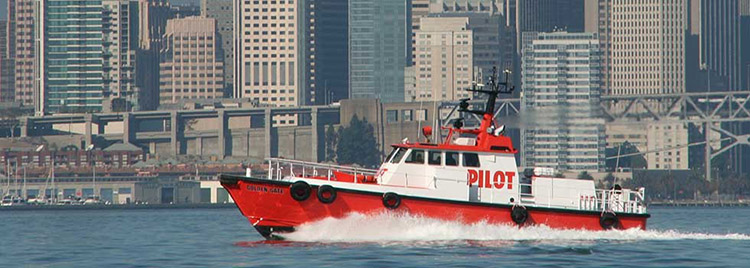San Francisco Bay is California's most important ecological habitat. It is home to sevengill sharks, Dungeness crab, salmon fisheries and countless other animals that rely on the Bay as a nursery.

For 165 years, the San Francisco Bar Pilots have guided the world’s largest ships through some of North America’s most difficult waterways. Photo courtesy of SF Bar Pilots.
By Mallory Johnson
Published: March, 2015
That’s where the San Francisco Bar Pilots come in. For 165 years, the San Francisco Bar Pilots have guided the world’s largest ships through some of North America’s most difficult waterways. These highly skilled maritime experts take on this demanding and dangerous job all year long, performing a critical public service. The Bar Pilots navigate oil tankers, container ships, cruise ships and more through the Bay’s difficult thoroughfare, delivering passengers, agricultural products, manufactured goods and hazardous materials, all while protecting the Bay, its habitat and its animals.
In 2013, the Bar Pilots partnered with Aquarium of the Bay to sponsor the Sea Lion Center, located just above the California sea lions’ hangout on PIER 39. With a common mission to protect the water quality and marine life of San Francisco Bay, the partnership between the Bar Pilots, Aquarium of the Bay and the Sea Lion Center was a natural fit.
I recently spoke with the president of the San Francisco Bar Pilots, Captain Peter McIsaac, to find out more about what it takes to be a Bar Pilot.
Bay Crossings: Why are the San Francisco Bar Pilots important to the Bay?
The San Francisco Bar Pilots provide the first line of environmental protection for the Bay, working to ensure the safe and secure passage of vessel traffic. During the Gold Rush, state lawmakers recognized the importance of safe navigation on the Bay, and in 1850 enacted legislation establishing the pilots and pilot regulation. On the job and in training, we work repeatedly to make sure our pilots use the latest technology and best practices to navigate ships in and out of Northern California waterways.
In the past, the pilots’ role was to protect the ship from the environment, but now we see our role as protecting the environment from the ship while still ensuring the efficient movement of goods.
BC: How do the Bar Pilots benefit the economy?
International trade and shipping are vital parts of the California economy. We help facilitate commerce for businesses and consumers here and also ensure that California goods can reach important foreign markets, such as China. We pilot thousands of vessels a year and help keep goods, commodities and products going where they need to go.
BC: In the Sea Lion Center, we have one of your rope ladders on display. What is this ladder used for and how does it work?
This is a pilot ladder and it is essentially a series of wooden or fiberglass steps held together by side ropes. The pilot uses it to embark or disembark from our boat (the pilot boat) to the ships in the middle of the Bay. It is meant to be flexible so it can be rolled up and stored on the deck of the ship when not in use. When deployed, it rests against the hull of the vessel and is latched at the top. The ladder is the most physically demanding and dangerous aspect of piloting.
BC: Why do the Bar Pilots drive the ships rather than the ship’s captain?
It may be the captain’s first and only visit to San Francisco Bay. The pilot provides the local expertise to ensure a safe and efficient passage. Not only do we know the grounds like the backs of our hands, but we also know the local regulations, communication protocols and more. The pilot assumes navigational control, although it’s still the captain’s ship.
BC: Navigating these waters sounds like no easy task. What kind of training goes into being a Bar Pilot?
First, there is a completive exam process administered by the California Board of Pilot Commissioners (BOCP). If accepted into the training program, it takes from one to three years before the pilot trainee is commissioned by the BOCP. After that, there is a two-year professional development program mandating that the pilot work under the direction of a senior pilot on some challenging transits. We also go through classroom, simulated and manned model training on a regular schedule.
BC: What made you decide to become a Bar Pilot?
My maritime career started on the Great Lakes over 35 year ago during a summer break from my rather unfocused college studies. I ended up as a quartermaster on a tug towing oil barges around the lakes. Two years later I went to work in Alaska for Crowley Maritime. After a stop in Seattle, I ended up in San Francisco working at Pier 9, of all places, as a senior port captain. My stint in management lasted two years before deciding to focus on becoming a pilot.
BC: Is there anything else people should know about the San Francisco Bar Pilots?
Many of our pilots are sailors, surfers, Bay swimmers and conservationists who are passionate about protecting San Francisco Bay. The Bay is where we work, live and play. Additionally, pilots generously donate their personal time to mentor area youth who may be considering a maritime career. We are proud of our 165-year history of serving the citizens of California and the Bay Area.
You can learn more about the San Francisco Bar Pilots online at www.sfbarpilots.com.
Mallory Johnson is the Public Relations Coordinator for Aquarium of the Bay, a nonprofit organization dedicated to protecting, restoring and inspiring the conservation of San Francisco Bay and its watershed.

